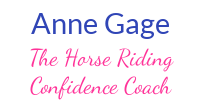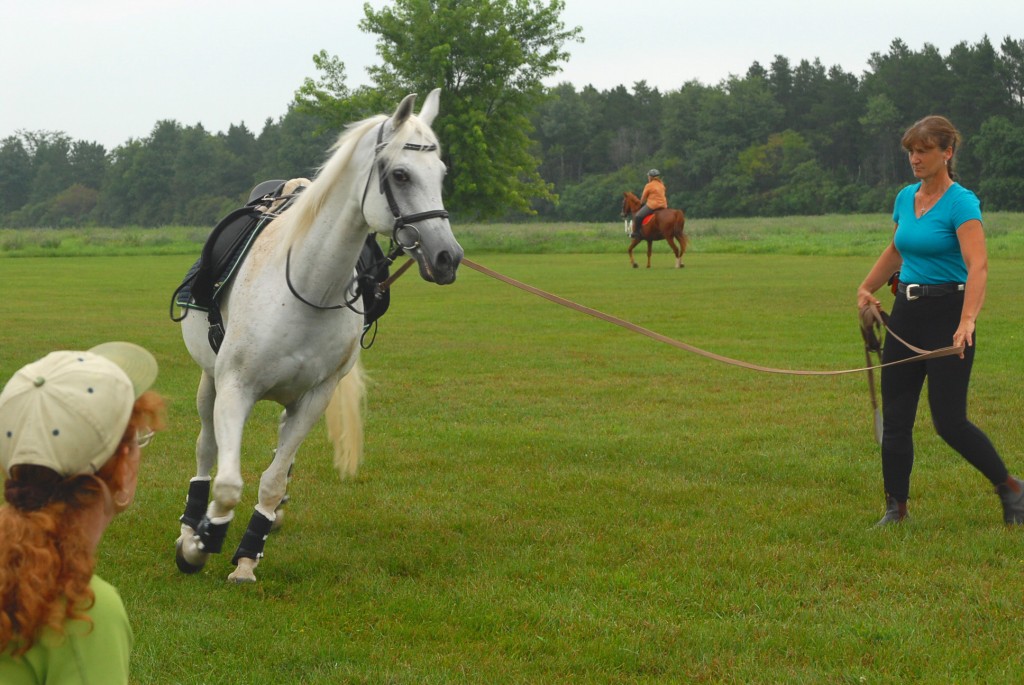by Anne Gage of Confident Horsemanship
“I have a young Gelding who was broken in without any lunging experience. When it come to introducing this to him it seems like we are working backwards. I am really struggling to teach him to understand what i am asking of him. We get a couple of good circles which always follows with him turning to face me. Would really appreciate some advice on how to improve this in the correct way. Any assistance would be greatly appreciated. Regards Emma”
“My horse won’t lunge” is a common complaint of many horse owners.
Lunging can be a positive and effective way of working with a horse when it is done in a way that helps the horse be balanced and relaxed. Some of the common problems people have when lunging their horses are:
- refusing to go forward
- turning in and facing the person
- bucking, rearing or bolting away
- racing around the circle unbalanced and counter bent
If your horse won’t lunge properly and safely then the problem just might be your alignment and where your energy is going.
Alignment simply refers to where your core hips and shoulders are aimed in relation to your horse’s head, shoulder and hips. Because horses are experts at reading body language, they are very sensitive to your posture, energy and alignment.
If you lunge using the traditional method I was first taught, you create a triangle with your horse as the base, you as the point and your arms as the sides. When you’re lunging to the left, you step to the left leading with your left foot. The problem with this position – especially for sensitive horses – is that the horse reads the line of energy coming from the left side of your body and that energy gets in his way. Depending on your horse’s personality, he will either turn in to face you, refuse to move forward, or buck, rear or bolt away.
The photo below illustrates the best position for lunging your horse. My core or centre (where my belt buckle is) is aimed into the centre of the horse’s shoulder. My left shoulder is open – that is pulled slightly away from – the horse’s head. My right hip is angled towards the horse’s hip. I am walking around a small circle with my right foot stepping slightly towards the horse’s flank and my left foot stepping slightly towards his girth.
One way to get a feel for this posture and way of stepping is to push a wheel barrow in a circle. If you want the wheelbarrow to move in a circle to the left, you must angle your body slightly into the arc of the circle. Your left shoulder (on the inside of the arc) will be open or slightly behind the right (outside) shoulder. Your hips will be aligned with your shoulders. Your right foot will step forward and slightly out of the arc. Your left foot will step forward and slightly towards the outside of the arc. Try taking the same position and stepping in the same way when you lunge your horse.
From this position, you can direct your horse’s forward movement while controlling where his shoulders and hips go by sending pushing energy to the appropriate part of his body. You can talk to him through your own body – your hip, arm or core can all send pushing energy. If necessary, the end of your lunge line or a lunge whip can be used to create stronger driving energy. For example, to ask your horse to go forward, push into his flank with your nearest arm or by swinging the end of your lunge line or the lash of a lunge whip towards the flank area. The flank is the “button” where one horse pushes or bites another horse to tell him or her to “go forward”.
Always bring the rope or the whip’s lash from the ground upwards towards the horse. For more push, continue with this movement increasing the RPM’s (rounds per minute) of the lash in this circular movement. You don’t need to hit your horse with the whip, just twirl it faster. This movement is much less aggressive to the horse than snapping the whip.

- move the circle
- change the size of the circle (spiral in or out for lateral movement)
- bring your horse into balanced alignment.
Once you are working with the correct alignment between yourself and the horse, and pushing the right “buttons”, your horse should go forward in a relaxed, willing and cooperative way.
Click here to watch my video showing the correct alignment for lunging.
There are lots more practical and in depth tips on improving your Confidence and your Partnership with your horse in my book “Confident Rider, Confident Horse: Build Your Confidence While Improving Your Partnership with Your Horse from the Ground to the Saddle”. Click here to order your copy today!
Click here to read the next article. Click here to return to Article Directory

